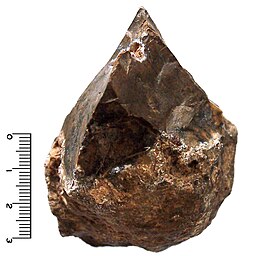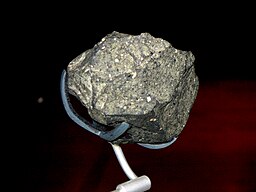奥都万
奥都万,又称奥杜韦文化(Oldowan)、模式I,是在史前普遍使用的一种石器的工业考古学(Industrial Archeology)风格。这些早期的工具十分简易,其典型技术特征为“砍砸器”。砍砸器是从石核的部分表面去除石片,形成用于切割、砍砸和刮削的锋利边缘,对于从石核敲出的石片所进行的表面微观分析表明,某些石片也作为切割植物和屠宰动物的工具[2]。在旧石器时代初期(260万年前至至少170万年前)非洲、南亚、中东和欧洲大部分地区的古人类(早期人类)皆使用过奥都万工具。紧随在该技术工业之后的是更为复杂的阿舍利工业(在埃塞俄比亚阿法尔地区戈纳有两个与直立人有关的遗址,分别距今150万年和126万年,遗址兼具奥都万及阿舍利工具)。[3]
 | |
| 地理范围 | 欧亚非大陆 |
|---|---|
| 时期 | 旧石器时代初期 |
| 时间 | 公元前260万年–170万年 |
| 主要遗址 | 奥杜维峡谷 |
| 先前文化 | 洛迈奎[1] |
| 继承文化 | 阿舍利 |
“奥都万”(Oldowan)一词取自坦桑尼亚的奥杜维峡谷遗址,考古学家路易斯·李奇于1930年代在那里发现了第一批奥都万石器。然而,当代一些考古学家和古人类学家更倾向于用“模式1”工具一词来指称砾石工具工业(包括奥都万),“模式2”指称双面加工工具(包括阿舍利手斧),“模式3”指称准备好核心之工具(最著名的是勒瓦娄哇技法[4]),等等。[5]
目前对奥都万工具的分类仍有所争议。玛丽·李奇是第一个建立系统对奥都万聚簇(assemblage)进行分类的人,并根据规定的用途建立了她的系统,该系统包括砍砸器、刮削器和捶打器。[6][7]然而,由于对人造石器用途的假设仍存在问题,近期对奥都万聚簇的分类主要集中在制品方面。例如,Isaac等人的三类别:“打制修理类”(Flaked pieces,石核/砍砸器)、“废片类”(Detached pieces,石片和碎片)、“打击类”(Pounded pieces,用于锤打的砾石等)和 “未经打击的产品”(运送至遗址的石块)。[8]奥都万工具有时被称为“砾石工具”,之所以如此命名,是因为生产所选的胚料已经很像砾石形式的最终产品。[9]
目前尚未弄清楚是哪一种类人猿创造并使用了奥都万工具,通常奥都万工具的出现与惊奇南方古猿这个物种有关[10],并与能人和匠人等早期人属物种一起蓬勃发展。早期直立人似乎继承了奥都万技术,并在170万年前开始将其完善为阿舍利工业。[11]
尼古拉斯·托斯(Nicholas Toth)的研究表明,对早期石器制造者而言,最重要的工具可能是从砍砸器和砾石工具取下的锋利石片,而非砍砸器和砾石工具本身。[12][13][14][15]





工具
编辑形状和用途
编辑玛丽·李奇将奥都万工具分为重型、轻型、可利用的碎片(utilized pieces)和废片(debitage)。[16]重型工具主要是石核工具。砍砸器的一侧带有刀刃,如果刀刃是透过剥落石核的一个面而形成,就是单面的(unifacial),如果是剥落两个面,那么就是双面的(bifacial)。盘状工具(Discoid tools)则大致为圆形,有外围刀刃。多面体工具(Polyhedral tools)的刀刃是多面体的形状。此外,还有球状的锤石。
轻型工具主要是石片工具。有刮削器、锥子(有用于钻孔的尖端)和雕刻器(有用于雕刻的尖端),有些功能也是重型工具所拥有的。例如,重型刮削器。
可利用的碎片工具是指一开始只有一个目的,却被偶然利用。
奥都万工具可能有很多用途,这些用途是透过对现代类人猿和狩猎采集者的观察发现的。例如有些石头会作砧座之用,可透过锤石在砧座上敲裂坚果和骨头。充满破损和凹痕的石头证明了这种用途的可能性。
重型工具可以作为用于木材加工的斧头,砍砸器和大石片都可能被用于此目的。例如一旦将木材分离,就可以用刮削器刮干净,或者用尖状器将其挖空。透过观察用于刮削木材的刀刃所特有的微观变化,这种用途就可得到证明。奥都万工具也可以用来准备皮革,兽皮必须透过划破、刺穿和刮净残留物来进行切割,石片最适用于此目的。
劳伦斯·基利(Lawrence Keeley)追随谢尔盖·塞门诺夫(Sergei Semenov)的脚步,重新制造了工具,并依最初推测的用途来使用,接着对这些工具的刀刃进行微观研究(使用高功率光学显微镜)。他发现这些使用特征的痕迹与史前工具的痕迹相符。用电子显微镜研究骨头上的切割痕迹也得出类似的结果。
遗址
编辑完整的奥都万遗址一览表无法在此处列出。一些较知名的遗址包括:
笔记
编辑- ^ The Oldowan is classically considered the oldest industry of the Lower Paleolithic. The postulate of an even earlier, possibly pre-human (australopithecine) "Lomekwian" industry is due to Harmand, S.; et al. 3.3-million-year-old stone tools from Lomekwi 3, West Turkana, Kenya. Nature. 2015, 521 (7552): 310–315. Bibcode:2015Natur.521..310H. PMID 25993961. S2CID 1207285. doi:10.1038/nature14464.
- ^ Oldowan and Acheulean Stone Tools | Museum of Anthropology. anthromuseum.missouri.edu. [2021-06-21]. 原始内容存档于2021-05-07.
- ^ Semaw, Sileshi; Rogers, Michael J.; Simpson, Scott W.; Levin, Naomi E.; Quade, Jay; Dunbar, Nelia; McIntosh, William C.; Cáceres, Isabel; Stinchcomb, Gary E. Co-occurrence of Acheulian and Oldowan artifacts with Homo erectus cranial fossils from Gona, Afar, Ethiopia. Science Advances. 4 March 2020, 6 (10): eaaw4694. Bibcode:2020SciA....6.4694S. PMC 7056306 . PMID 32181331. doi:10.1126/sciadv.aaw4694.
- ^ Levallois technique. Oxford University Press. [30 October 2020]. (原始内容存档于2021-04-20).
- ^ Clark, J. G. D. World prehistory: a new outline. Cambridge: Cambridge University Press. 1969.
- ^ Clark, J.; de Heinzelin, J.; Schick, K.; Hart, W.; White, T.; WoldeGabriel, G.; Walter, R.; Suwa, G.; Asfaw, B.; et al. African Homo erectus: Old radiometric ages and young Oldowan assemblages in the middle Awash Valley, Ethiopia. Science. 1994, 264 (5167): 1907–1909. Bibcode:1994Sci...264.1907C. PMID 8009220. doi:10.1126/science.8009220.
- ^ Leakey, Mary. A Summary and Discussion of the Archaeological Evidence from Bed I and Bed II, Olduvai Gorge, Tanzania. Human Origins. 1971: 431–460.
- ^ Isaac, G. Ll., Harris, J. W. K. & Marshall, F. 1981.
- ^ Napier, J. Fossil Hand Bones from Olduvai Gorge. Nature. November 1962, 196 (4853): 409–411. Bibcode:1962Natur.196..409N. doi:10.1038/196409a0.
- ^ De Heinzelin, J; Clark, JD; White, T; Hart, W; Renne, P; Woldegabriel, G; Beyene, Y; Vrba, E. Environment and behavior of 2.5-million-year-old Bouri hominids. Science. 1999, 284 (5414): 625–9. Bibcode:1999Sci...284..625D. PMID 10213682. doi:10.1126/science.284.5414.625.
- ^ Richards, M. P. A brief review of the archaeological evidence for Palaeolithic and Neolithic subsistence. European Journal of Clinical Nutrition. December 2002, 56 (12): 1270–1278. ISSN 1476-5640. PMID 12494313. doi:10.1038/sj.ejcn.1601646 (英语).
- ^ Toth, Nicholas. The oldowan reassessed: A close look at early stone artifacts. Journal of Archaeological Science. March 1985, 12 (2): 101–120. doi:10.1016/0305-4403(85)90056-1.
- ^ Toth, Nicholas. The First Technology. Scientific American. April 1987, 256 (4): 112–121. ISSN 0036-8733. doi:10.1038/scientificamerican0487-112.
- ^ Toth, Nicholas; Clark, Desmond; Ligabue, Giancarlo. The Last Stone Ax Makers. Scientific American. July 1992, 267 (1): 88–93. ISSN 0036-8733. doi:10.1038/scientificamerican0792-88.
- ^ Toth, Nicholas; Schick, Kathy D.; Savage-Rumbaugh, E.Sue; Sevcik, Rose A.; Rumbaugh, Duane M. Pan the Tool-Maker: Investigations into the Stone Tool-Making and Tool-Using Capabilities of a Bonobo (Pan paniscus). Journal of Archaeological Science. January 1993, 20 (1): 81–91. doi:10.1006/jasc.1993.1006.
- ^ There is a good online summary of Mary's classification on Effland's site for Anthropology ASB22 (页面存档备份,存于互联网档案馆) at Mesa Community College in Arizona, apparently written by Effland.
资料来源
编辑- Braidwood, Robert J., Prehistoric Men, many editions.
- Domínguez-Rodrigo, M.; Pickering, T. R.; Semaw, S.; Rogers, M. J. Cutmarked bones from Pliocene archaeological sites at Gona, Afar, Ethiopia: Implications for the function of the world's oldest stone tools. Journal of Human Evolution. 2005, 48 (2): 109–121. PMID 15701526. doi:10.1016/j.jhevol.2004.09.004.
- Edey, Maitland A., The Missing Link, Time-Life Books, 1972.
- Schick, Kathy D.; Toth, Nicholas, Making Silent Stones Speak', Simon & Schuster, 1993, ISBN 0-671-69371-9
- Semaw, Sileshi. The World's Oldest Stone Artefacts from Gona, Ethiopia: Their Implications for Understanding Stone Technology and Patterns of Human Evolution Between 2·6–1·5 Million Years Ago. Journal of Archaeological Science. 2000, 27 (12): 1197–1214 [2021-04-18]. doi:10.1006/jasc.1999.0592. (原始内容存档于2020-07-28).
- Isaac, Glynn and Harris, JWK The Scatter between the Patches 1975
- Isaac, Glynn. The Food Sharing Behavior of Protohuman Hominids. Scientific American. 1978, 238 (4): 90–108. Bibcode:1978SciAm.238d..90I. PMID 418504. doi:10.1038/scientificamerican0478-90.
- Binford, Lewis (1987) Searching for Camps and Missing the Evidence: Another Look at the Lower Paleolithic
- Toth, Nicholas (1985) The Oldowan reassessed: a close look at early stone artifacts Journal of Archaeological Science
- Susman, Randall L, Journal of Anthropological Research, Vol. 47, No. 2, A Quarter Century of Paleoanthropology: Views from the U.S.A. (Summer, 1991), pp. 129–151
外部链接
编辑- Oldowan Pebble Tools of Europe (页面存档备份,存于互联网档案馆)
- Oldowan Pebble Tools of Africa (页面存档备份,存于互联网档案馆)
- Oldowan Flake Tool (页面存档备份,存于互联网档案馆)
- Stone Age Hand-axes,存档于互联网档案馆(存档日期 February 4, 2007)
- Early Palaeolithic
- Stone Age Reference Collection
- Microwear polishes on early stone tools from Koobi Fora, Kenya (页面存档备份,存于互联网档案馆), article in Nature 293, 464–465 (8 October 1981). The summary and the references are displayed at no charge at the Nature site.
- Geoarchaeology of the earliest paleolithic sites (Oldowan) in the north Caucasus and the East Europe
- An Ape's View of the Oldowan,存档于互联网档案馆(存档日期 May 21, 2008), T. Wynn and W.C. McGrew, Man 24:383–398; 1989.
- Plummer, Thomas. Flaked Stones and Old Bones: Biological and Cultural Evolution at the Dawn of Technology (PDF). Yearbook of Physical Anthropology. 2004, 47: 118–164 [2021-04-18]. PMID 15605391. doi:10.1002/ajpa.20157. (原始内容 (PDF)存档于2007-06-29).